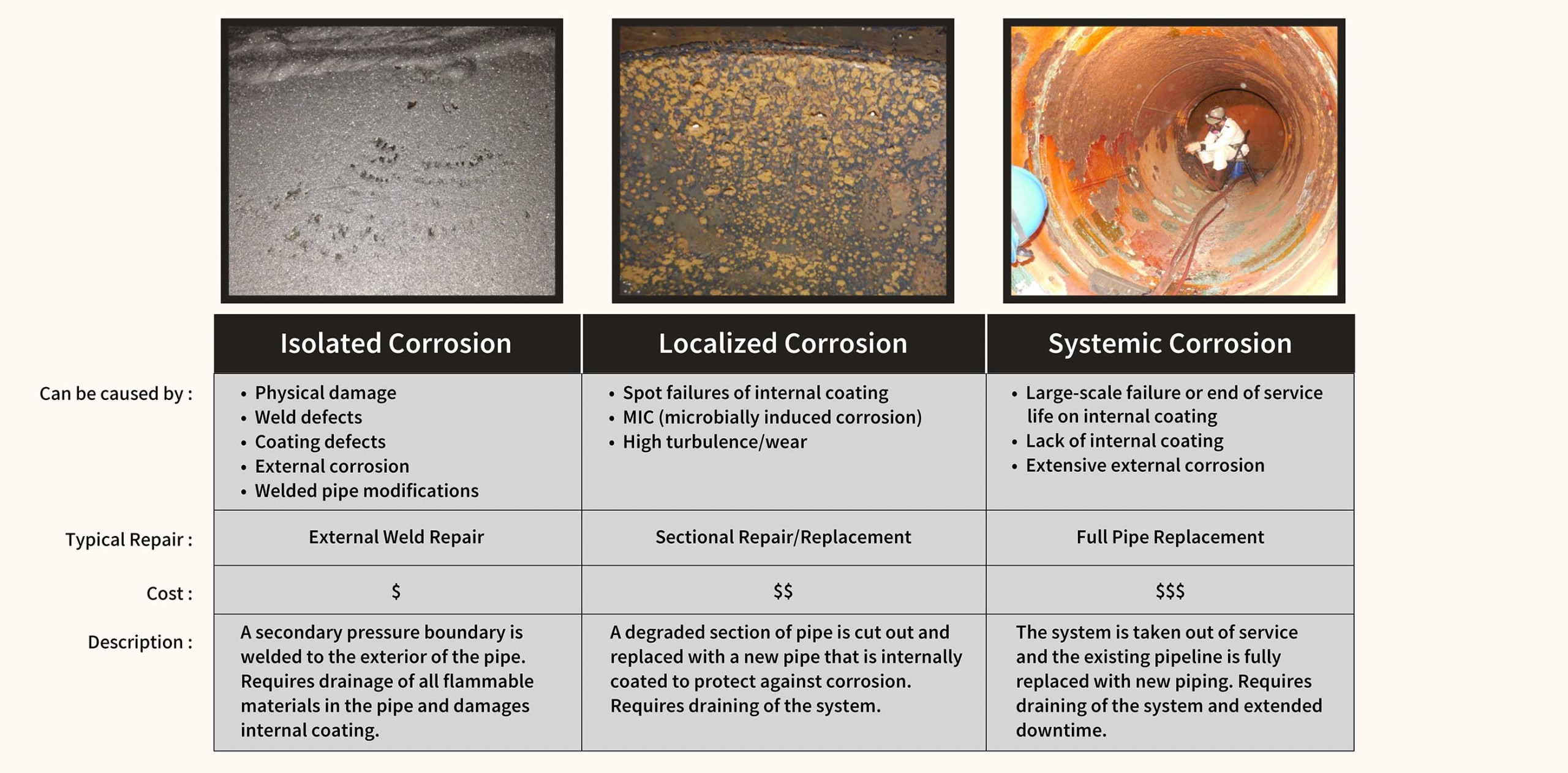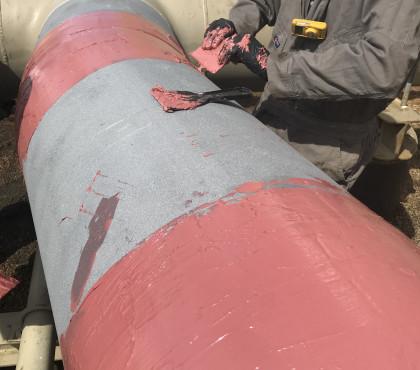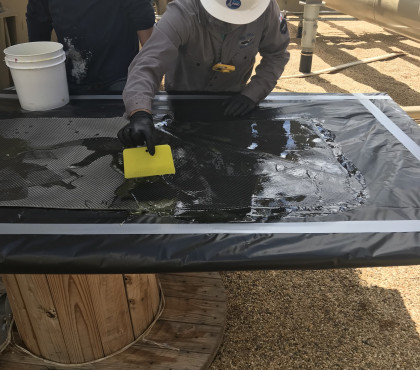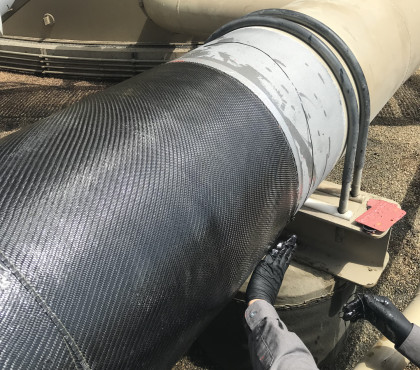Background
An Oil and Gas company found significant corrosion on a section of 30” diameter, crude oil piping at one of their terminal facilities. A routine ultrasonic thickness inspection of the pipe demonstrated that the pipe was experiencing internal corrosion with areas showing greater than 80% wall loss. As this was well below the Tmin (minimum wall-thickness) threshold for the piping system, it was immediately depressurized. The corporate engineering staff was tasked with finding a fast, economical, long-term solution compliant with all pertinent API and ASME requirements.
Read on to learn how Advanced FRP Systems helped the facility address their internal corrosion issue using externally applied Carbon Fiber Repair Kits. These pipeline repair kits were designed to provide structural reinforcement on pipes, fully compliant with ASME PCC-2 (2018) standards for operating pressures up to 1,000 psi, even with through-wall pipeline failures on the host pipe.
Immediate Challenge
Traditionally, there have been several repair options for internal corrosion on the oil pipelines available to the asset owners. Typically, as the extent and severity of the corrosion increases, so does the complexity of the repair or replacement as well as the associated cost and required system downtime.
In this particular situation, the engineering team suspected localized corrosion based on the available information from the original UT test report. Additional ultrasonic thickness analysis performed on the piping system showed that most of the piping system was not experiencing corrosion, but specific sections had extensive pitting. This pointed to localized corrosion most likely due to spot failures of the internal coating system coupled with Microbially influenced corrosion that is common in the area.
Having identified the cause and severity of the corrosion, the team worked to identify a repair solution. Replacement of an entire pipe section was not an option as the piping system could not be drained without taking the entire facility offline due to a lack of sufficient isolation valves. The engineering team explored alternative solutions, including composite repair options, specifically externally applied carbon fiber composites. They spoke with multiple potential suppliers to determine the feasibility of this repair option for their system.
In initial conversations, the engineering team outlined the following requirements for the composite repair solution:
- Be compliant with the ASME PCC-2 (2018) standards for Nonmetallic Composite Repair Systems: High-Risk Applications
- Be able to provide a long-term solution even with the development of through-wall failures under the composite as there were no plans made to address the internal corrosion
- Be able to provide the option to not grit blast areas of the pipe with the most severe corrosion to ensure an oil leak did not occur during application
- Be easy to install with application training done remotely as specialty contractors could not be mobilized during a global COVID-19 pandemic.
How Advanced FRP Met the Client’s Needs using Carbon Fiber Repair Kits
The engineering staff questioned if an external, composite repair methods could provide a long-term solution despite continued internal and external corrosion that would eventually lead to a through-wall failure. Their requirements specified the list of capabilities a solution had to have. Advanced FRP Systems was the only supplier able to address all their needs. We offered our Carbon Fiber Repair Kits which are easy to apply, thoroughly tested and readily available.
| REQUIREMENT | SOLUTION |
| After consulting with composite repair experts, the engineering team realized that any repair had to be designed for 100% wall loss as the internal corrosion would eventually create a through-wall failure. ASME PCC-2 requires multiple additional tests for repairs on pipes with through-wall failures. These tests include the energy release rate, impact performance, in-plane shear modulus and a full hydrostatic pressure test with a through wall failure on the host pipe. | Advanced FRP Systems’ Carbon Fiber Repair Kits were the only composite repair solution the engineering team found that meets or exceeds the stringent ASME PCC-2 (2018) requirements for repairs on high-risk piping, with up to 100% wall loss. The decision for the facility to choose Advanced FRP Systems was straightforward. |
| After reviewing the UT testing, the engineering team concluded that the pipes are experiencing localized corrosion in the form of pitting. The engineering team decided not to address the continued corrosion of the pipes and so needed a repair that would be fully structural and liquid-tight to protect against the development of through-wall failures. Further, specific areas on the pipe could not be grit blasted where the wall loss due to pitting was greater than 80%. The facility also wanted an option to add additional repairs at a later date, and tie them in directly to the previously applied composite repair system. | Advanced FRP Systems’ Carbon Fiber Repair Kits can be installed using an Adhesion Zone concept. This decreases the need for extensive grit blasting, allowing the required grit blasting to be limited to two 12-24 inch sections on either end of the identified repair sections.
One large size Carbon Fiber Repair Kit creates a fully structural repair for a 25-inch length of pipe, but can easily be overlapped, at the time of installation or even at a later date, with additional Carbon Fiber Repair Kits to create a larger repair. The overlapping of repairs does not sacrifice the overall pressure capacity or longevity of the repair. The adhesion zone concept is ideal for pipes operating below 1,000 psi internal pressure. |
| As the Covid-19 pandemic made it impossible to bring in specialty contractors to install the composite repair, the facility needed to train their internal maintenance team to install Carbon Fiber Repair Kits. Hands-on training and in-person oversight were impossible due to travel restrictions. | Advanced FRP Systems developed a comprehensive online training program for the maintenance staff. The maintenance staff was then able to install four, large-size Carbon Fiber Repair Kits for this critical repair without any issues or delays. Once the repair cured, the pipes were pressurized and have been operating without issue. |
Installation Process
As proper pipeline surface preparation is crucial to the longevity of a composite pipe repair, Advanced FRP provided a solution for the facility that would allow them to avoid full grit blasting of the pipe surface and the need to drain the flammable contents of the pipe. Based on the pressure and diameter of pipes, our adhesion zone concept only required the team to grit-blast a 12-inch band on either side of the repair area. This allowed the installation staff to safely blast, skipping any areas that recorded significant wall loss during the UT testing, without reducing the quality or longevity of the repair.
Step by Step Installation Process:
- Areas with more than 80% wall loss were masked off prior to grit blasting.
- The remainder of the surface was grit blasted to an SSPC SP-10 Near white metal finish with a 3 mil angular profile.
- FRP Repair Putty, a 100% solids epoxy putty, was applied to any irregularities like pitting and weld seams on the repair area.
- FRP 120 HT, a high-strength adhesive, was applied to the entire repair area via brush/roller at 5 – 10 mils DFT.
- CF-500 BD, a high-strength, bi-directional carbon fiber fabric was saturated with FRP 210 HT and applied in bands around the outside of the pipe.
- Carbon fiber bands were overlapped to cover the entire length of the repair.
- A total of six layers of the composite was installed, all in a single shift, wet on wet, without sagging or delaminating from the substrate.
- The composite was allowed to cure overnight and the HP-300 Epoxy topcoat was applied over the entire repair area via brush/roller at 15 – 20 mils.
Clients for Life
Advanced FRP was able to demonstrate the ability of our emergency carbon fiber pipe repair kits to provide full structural reinforcement on pipes with through-wall failures with an operating pressure up to 1,000 psi. Further, the repair system was fully compliant with the ASME PCC-2 (2018), Article 4.1, including pipes with through-wall failures. The end-user was so impressed by the ease of application and the performance of this composite repair solution for crude oil pipes that they decided to continue ordering more kits as additional repairs are required here or at any of their other facilities.
Having Issues with Pipe Corrosion or Erosion?
Contact us for a free evaluation!




